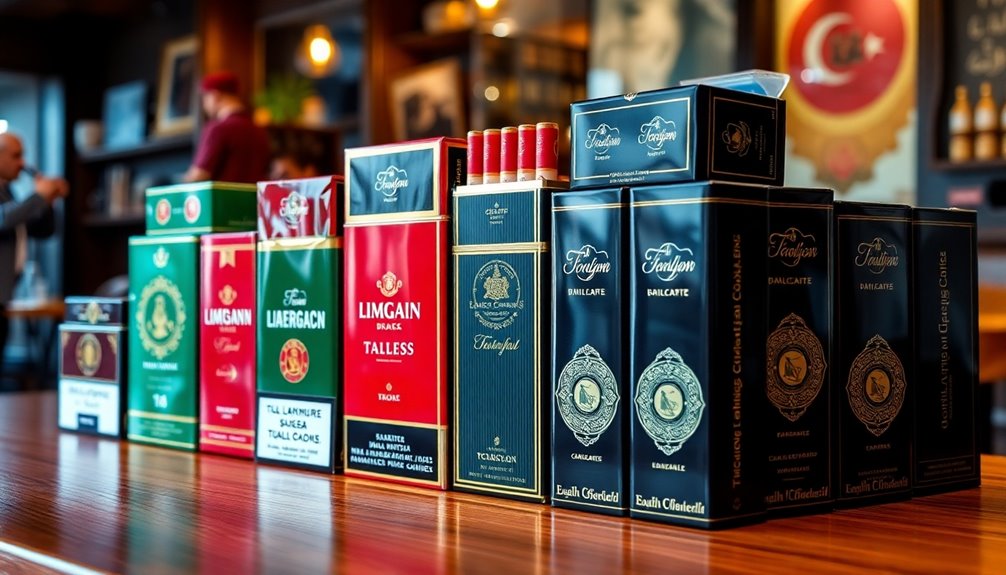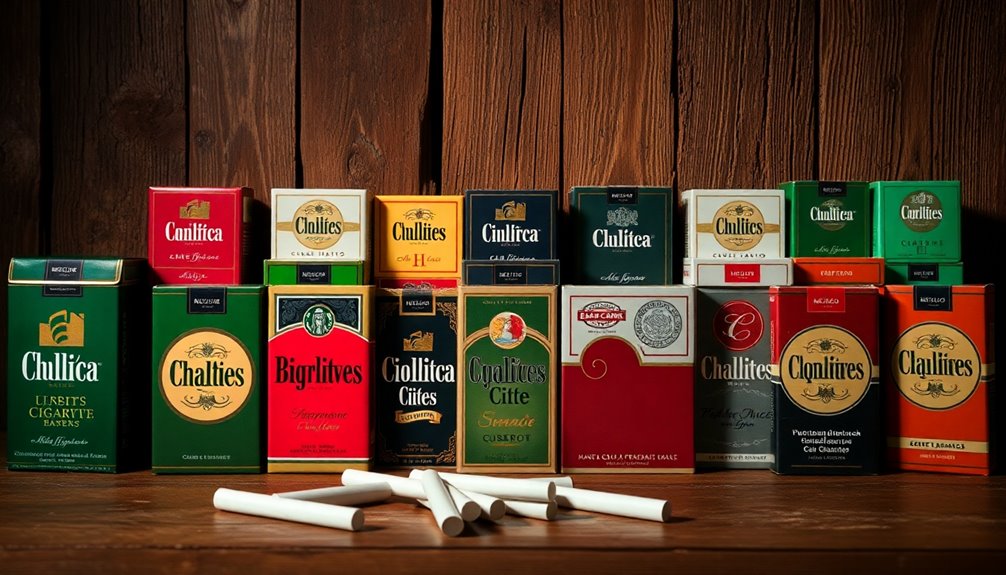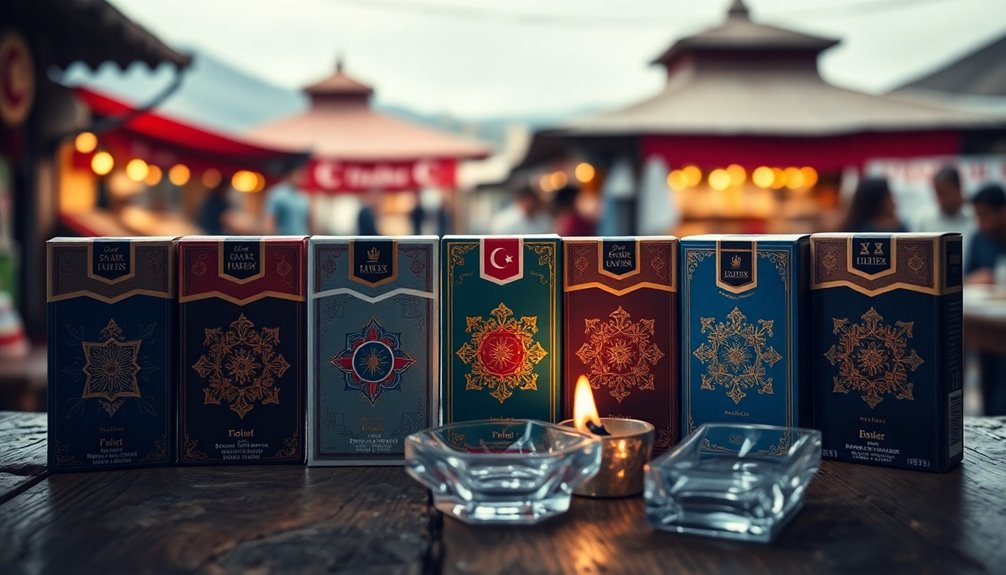If you're exploring Turkey's cigarette brands, you're in for a mix of classic and contemporary options. Notable local brands include Bahar Kirmizi, Meltem, and Tekel 2000, each with a strong market presence. International favorites like Camel, Winston, and Mevius also shine in Turkey's landscape. Historically significant brands like Murad and Fatima shaped the market but have since declined. Turkish tobacco regulations impact production and marketing, leading to innovative alternatives like heat-not-burn devices. Curious about how these brands evolved and what they offer today? There's a lot more to uncover about Turkey's dynamic cigarette scene.
Key Takeaways
- Local Brands: Popular local brands include Bahar Kirmizi, Istanblue Blue, Tekel 2000, Meltem, and Samsun, known for strong market presence and recognition.
- International Brands: Key international brands are Camel, Winston, Mevius, and Parliament Night Blue, favored for their quality and consistency.
- Historical Brands: Classic brands like Murad, Helmar, and Fatima reflect Turkey's rich tobacco history, initially popular for their pure Turkish tobacco.
- Niche Offerings: Brands such as Bond Street Gold and Esse Slim Bronze Label target specific consumer preferences, catering to diverse tastes in the market.
- Emerging Alternatives: The market is seeing a rise in heat-not-burn devices and e-cigarettes, with brands adapting to changing consumer trends towards safer smoking alternatives.
Overview of Turkish Cigarette Brands
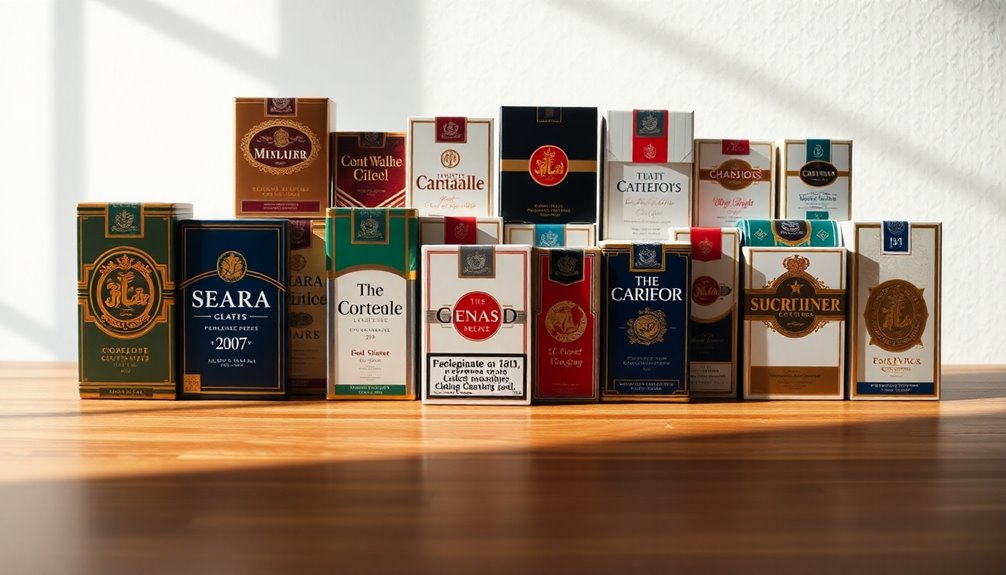
The landscape of Turkish cigarette brands reflects a complex interplay of market dynamics and consumer preferences. In Turkey, Philip Morris stands out as the clear leader in retail volume sales, while JTI and British American Tobacco closely follow. TEKEL, a state-owned enterprise, commands an impressive 70% share of the domestic market and is the largest tobacco exporter in the country. Since 1997, public-sector firms have dominated cigarette production, holding a substantial 78% market share.
You'll notice a remarkable increase in legal cigarette sales, which hit a record 189 billion sticks in 2023, reflecting a compound annual growth rate of 4.13% since 2013. This growth in production aligns with the rising tobacco consumption in Turkey, contrary to global trends. Moreover, Turkey accounts for 4% of global tobacco production, showcasing its significant role in the international market.
Small local grocers lead the distribution channels, supplemented by specialists in food, drink, and tobacco, alongside an uptick in forecourt retailers due to increased travel. Despite extensive legislation designed to control tobacco use, the industry remains robust, driven by a variety of distribution channels and product offerings. This vibrant market, however, contrasts sharply with the ongoing health concerns and economic repercussions associated with tobacco consumption.
Notable Local Brands
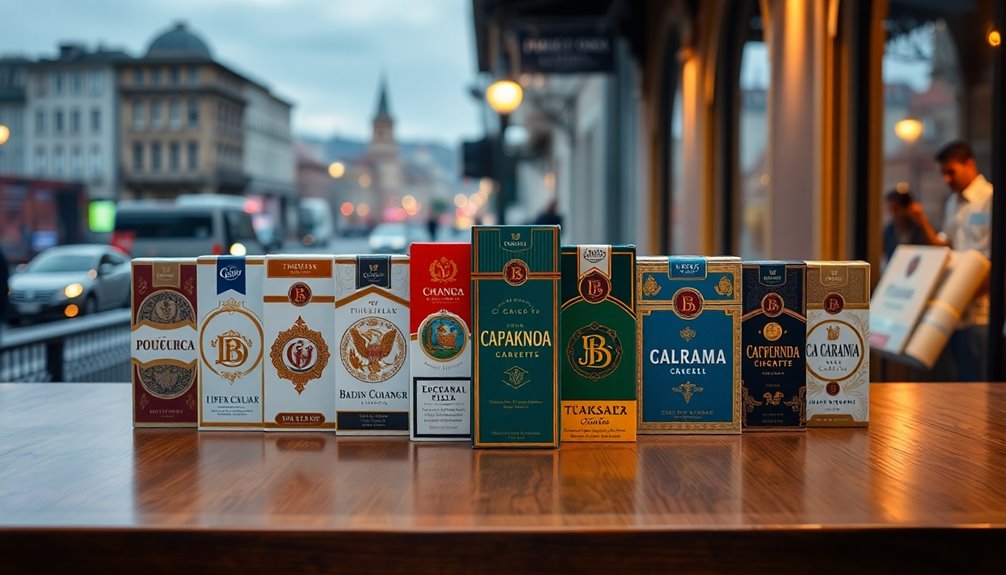
Exploring Turkey's notable local cigarette brands reveals a rich tapestry of options that cater to diverse consumer preferences. One standout is Bahar Kirmizi, produced by British American Tobacco and Tekel, which boasts a strong distribution network through local grocers.
Istanblue Blue, manufactured by Bogazici Tobacco, contributes to local market growth with its widespread availability.
Tekel 2000 and its variants, including Uzun Kirmizi and Uzun Mavi, are integral to Turkey's significant annual cigarette production, amounting to approximately 159.91 billion cigarettes. This production volume reflects Turkey's historical significance as a major tobacco producer in the region.
Meltem, another Tekel brand, is popular among forecourt retailers, benefiting from increased travel and tourism.
Samsun is particularly notable for its high brand recognition, especially among children, showcasing an impressive 95.2% name recognition and 80.8% logo recognition.
Tekel 2001, produced by British American Tobacco Türkiye, further enhances the Tekel legacy with its recognized variants.
These brands reflect not only a strong market presence but also the historical and cultural significance of Turkish tobacco, highlighting the blend of traditional and contemporary influences in the local cigarette scene.
Popular International Brands
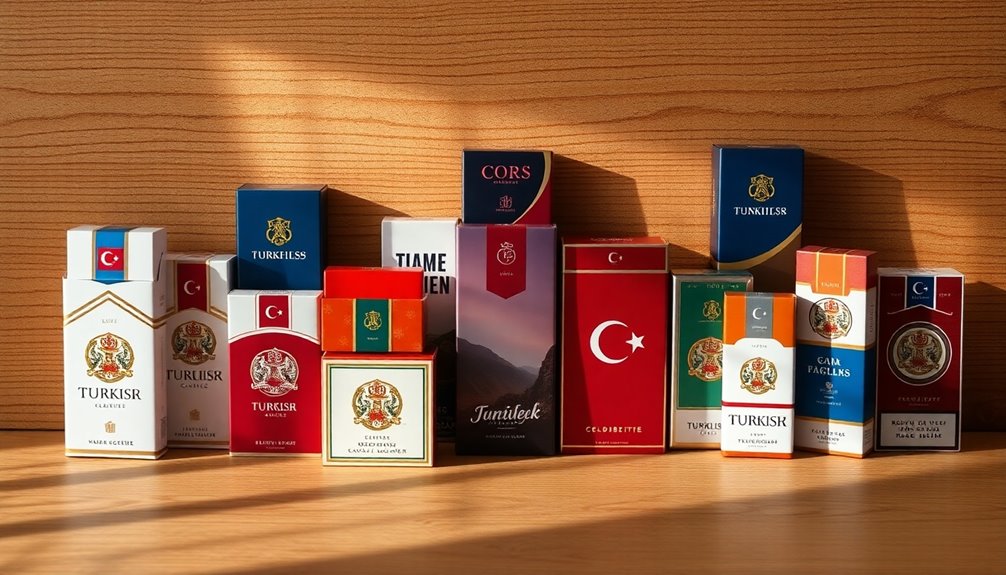
While many local brands dominate the Turkish cigarette market, popular international brands also play a significant role, catering to diverse consumer tastes.
You'll find brands like Camel and Winston, both distributed by JTI Türkiye, which are well-loved for their consistency and quality. Mevius, originally known as Mild Seven, is another flagship brand from JTI that's gained a strong following in Turkey. JTI has expanded its presence in multiple low- and middle-income countries, including Turkey, which reflects its commitment to international markets.
If you're looking for something different, you might enjoy Parliament, particularly the Parliament Night Blue variants, available through Philsa A.S.
There are also niche options like Bond Street Gold and Esse Slim Bronze Label, which cater to specific preferences. Brands like Benson & Hedges and Silk Cut make their mark in regional markets, adding variety to your choices.
British American Tobacco also has a solid presence with brands like Maltepe Kirmizi and Samsun 216, offering unique flavors that appeal to various smokers.
With Philip Morris International leading the market, you can expect a wide selection of international brands that meet different tastes and preferences in Turkey.
Whether you prefer classic or contemporary, there's something for everyone among these global offerings.
Historical Brands in Turkey
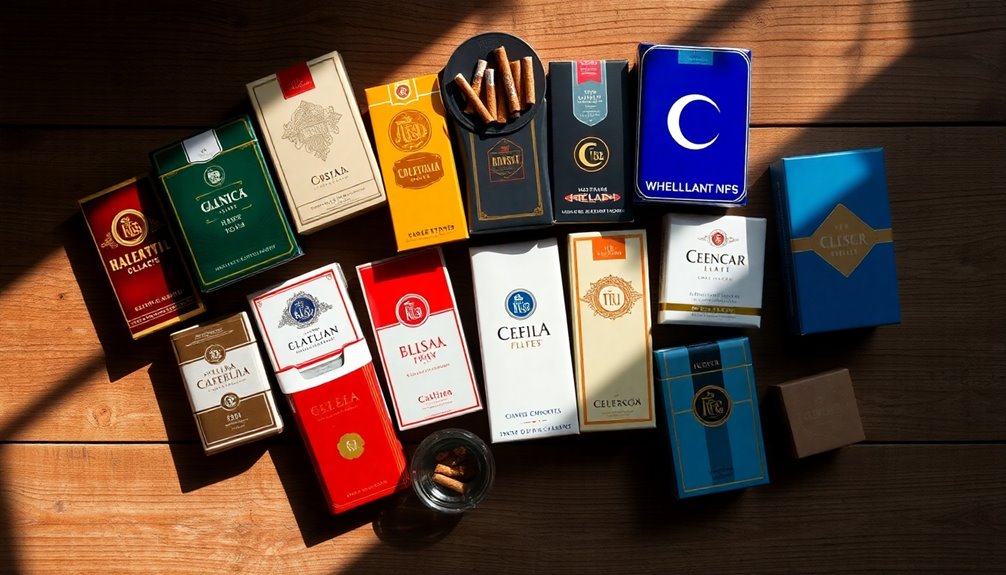
A rich history surrounds the cigarette brands that emerged in Turkey, particularly during the Ottoman Empire. Tobacco was introduced by the Spanish, and over time, Turkey developed unique methods for growing and using it. The sun-cured tobacco from regions like Thrace and Macedonia became known for its aromatic and acidic qualities.
Notable historical brands include Murad, famous for its hand-rolled cigarettes made from pure Turkish tobacco, produced by Soterios Anargyros. Helmar and Fatima offered cigarettes containing exclusively Turkish tobacco, while Balkan Sobranie gained recognition for its premium Turkish tobacco blends. Urban tobacconists like Fribourg & Treyer and Sullivan & Powell in London also produced Turkish cigarettes, highlighting the international appeal of these brands. Additionally, Turkish tobacco is often referred to as Oriental tobacco, emphasizing its historical significance in the global tobacco market.
The Cibali Tobacco Factory, founded in 1884, became one of the largest in the Ottoman Empire, processing a variety of tobacco types and employing many female workers in packaging.
Despite their initial popularity, brands like Murad, Helmar, and Fatima saw a decline due to shifting tastes towards Virginia tobacco after World War I, leading to their eventual disappearance from the market.
Market Leaders in Cigarette Production
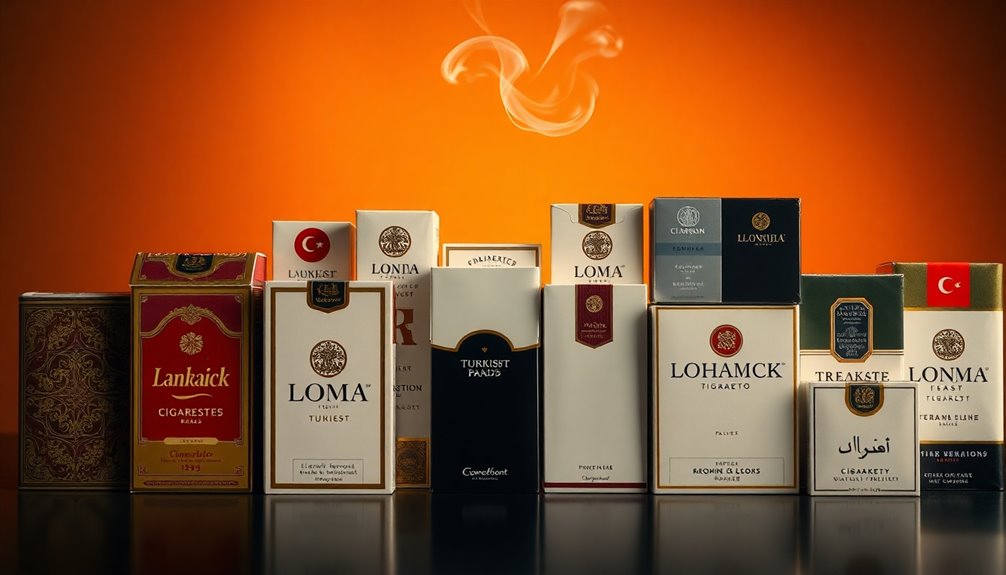
The evolution of Turkey's cigarette market has led to the rise of several dominant players in production today.
If you're looking at the landscape, Philip Morris International Inc stands out as the market leader, boasting popular brands like Parliament, Marlboro, and L&M. Japan Tobacco Inc is another significant force, offering well-known brands such as Camel, Camel Black, and Camel Green.
British American Tobacco Plc also holds a substantial market share, marketing brands like Bahar Kirmizi, Samsun 216, and Tekel 2000. Imperial Brands Plc rounds out the top companies, contributing a diverse range of products to the sector.
Local brands such as Tekel 2000 and Meltem remain popular and add to the competitive environment. The Turkish cigarette market was valued at TRY61.8 billion ($7 billion) in 2021 and is expected to grow at a CAGR of over 5% through 2026. This growth is also influenced by government policies aimed at limiting tobacco consumption.
With convenience stores as the primary distribution channel, cigarette sales have surged, reaching 189 billion sticks in 2023. These established companies continue to shape the market, driven by strong brand loyalty and extensive distribution networks.
Cigarette Consumption Statistics
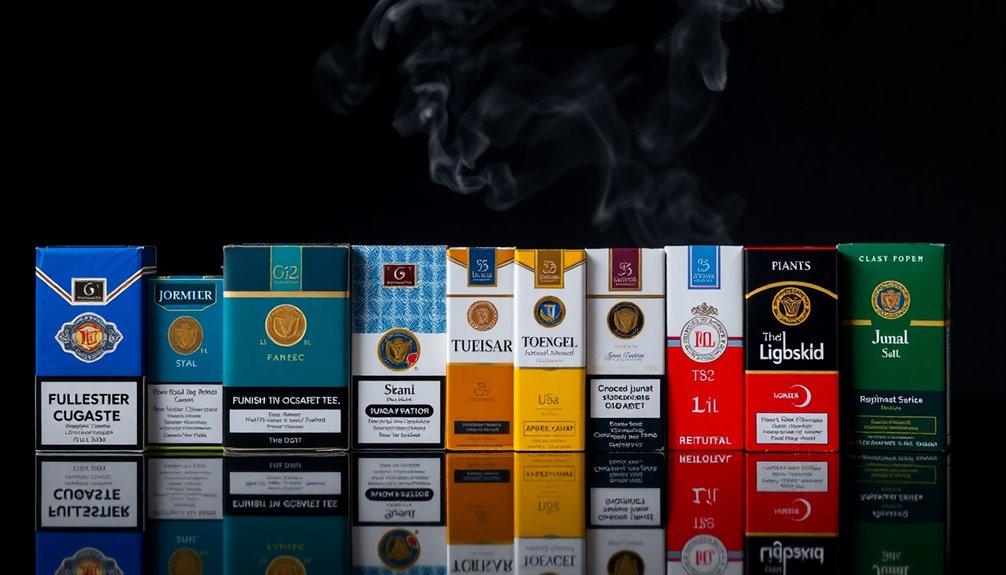
Cigarette consumption in Turkey reveals troubling trends, with 30.7% of adults aged 15 and older smoking tobacco. Among these, a staggering 41.9% of men and 19.6% of women are smokers. This amounts to nearly 20 million adult smokers, highlighting a significant public health issue.
Alarmingly, smoking prevalence rose by 20% from 2012 to 2022, with women's smoking rates increasing by 38.3% during the same period.
Youth smoking is also a concern, with 11% of those aged 10-14 engaging in tobacco use. Specifically, 10.3% of male youth and 12.3% of female youth smoke.
The statistics become even more alarming when looking at adolescents aged 13-15, where 17.9% currently smoke. Among them, 12.8% use other tobacco products, exposing a new generation to the risks of smoking. Additionally, 51.8% of youth are exposed to secondhand smoke in public places, further exacerbating the health risks associated with tobacco use.
The health consequences are dire, with nearly 85,000 deaths each year attributed to smoking-related diseases. This staggering statistic underscores the urgent need for effective interventions to combat tobacco use in Turkey and protect both current and future generations from its devastating impacts.
Tobacco Regulations in Turkey
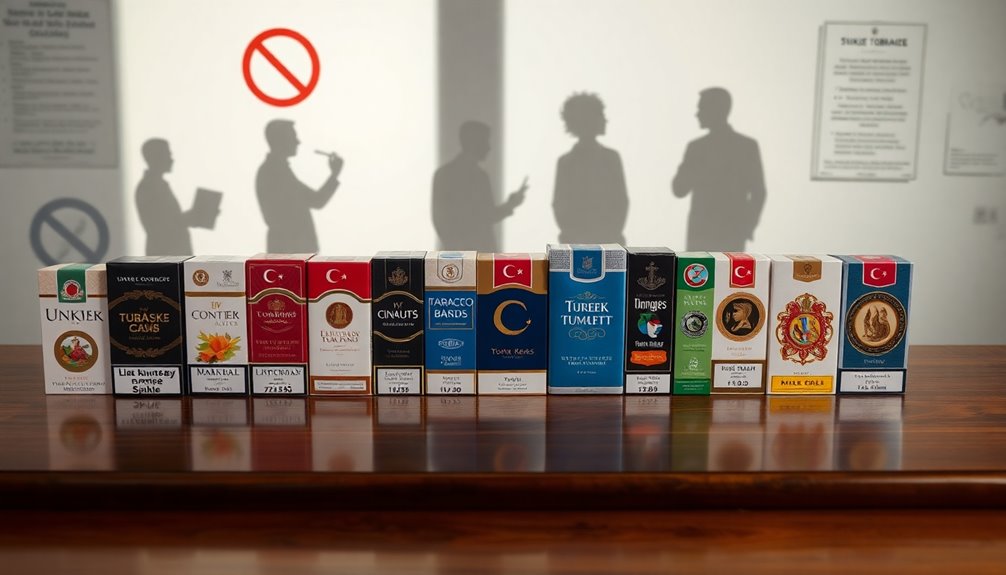
Tobacco regulations in Turkey aim to tackle the serious public health crisis posed by smoking. The primary law, Law No. 4207, covers public smoking, advertising, packaging, and educational campaigns while imposing penalties for violations. This was strengthened by Law No. 5727 in 2008, enhancing the effectiveness of these control measures.
You'll find that smoking is prohibited in most indoor workplaces and public places. Exceptions exist, such as ventilated smoking areas in certain facilities, but comprehensive bans have been in place since 2009, extending to hospitality venues and public transport.
Advertising and sponsorship face near-total bans, ensuring that tobacco products aren't promoted to the public. Even point-of-sale displays must remain hidden from outside view and away from minors.
Additionally, significant tax increases on tobacco products were implemented following the ratification of the WHO Framework Convention on Tobacco Control, contributing to a drop in cigarette sales. These regulations support a commitment to global tobacco control measures.
Lastly, a robust system to combat illicit trade has been established, including a track and trace system. These regulations reflect Turkey's commitment to reducing smoking rates and protecting public health.
Consumer Preferences and Recommendations
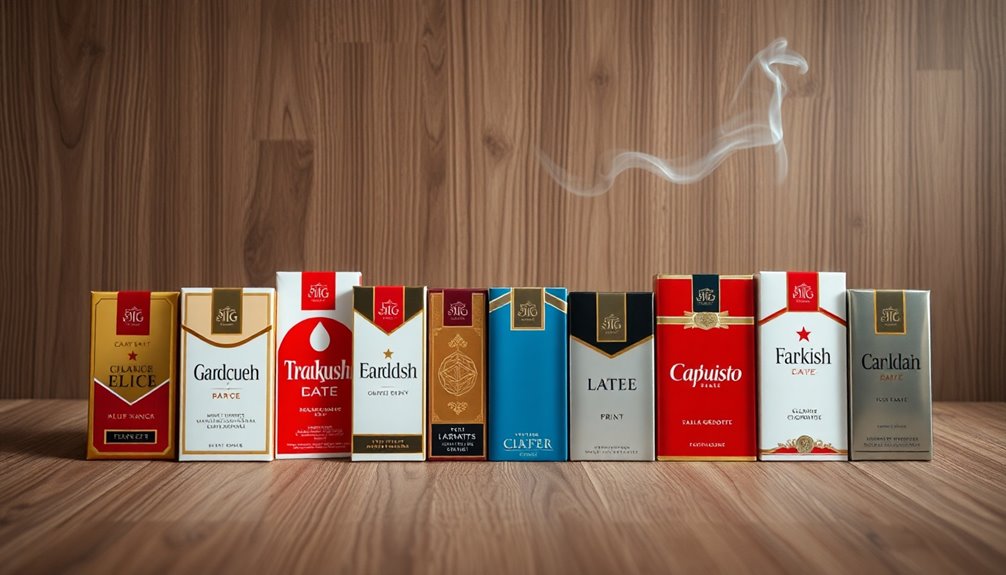
In Turkey, consumer preferences for cigarettes are shaped by a mix of local and international brands, with Philip Morris International Inc dominating the market. You'll find popular choices like Parliament, Marlboro, and Lark consistently leading sales.
Most smokers prefer filter cigarettes, especially king-size variants, which account for the largest share of the market.
Between 1990 and 2000, foreign brands witnessed remarkable growth, expanding their market share to 32%. This trend continues today, as many consumers are drawn to brands like Camel and Bond Street Gold due to their diverse flavor and size options.
If you're seeking recommendations, consider trying local brands like Bahar Kirmizi or Meltem for a unique taste.
When it comes to purchasing, convenience stores are your best bet, as they garner the highest sales. Hypermarkets and tobacco specialists also play significant roles in distribution.
Keep an eye out for promotional activities at these locations, which can offer better visibility and possibly savings.
Ultimately, your choice can depend on personal taste, brand loyalty, and the convenience of access, so explore different options to find what suits you best.
The Future of Cigarette Brands
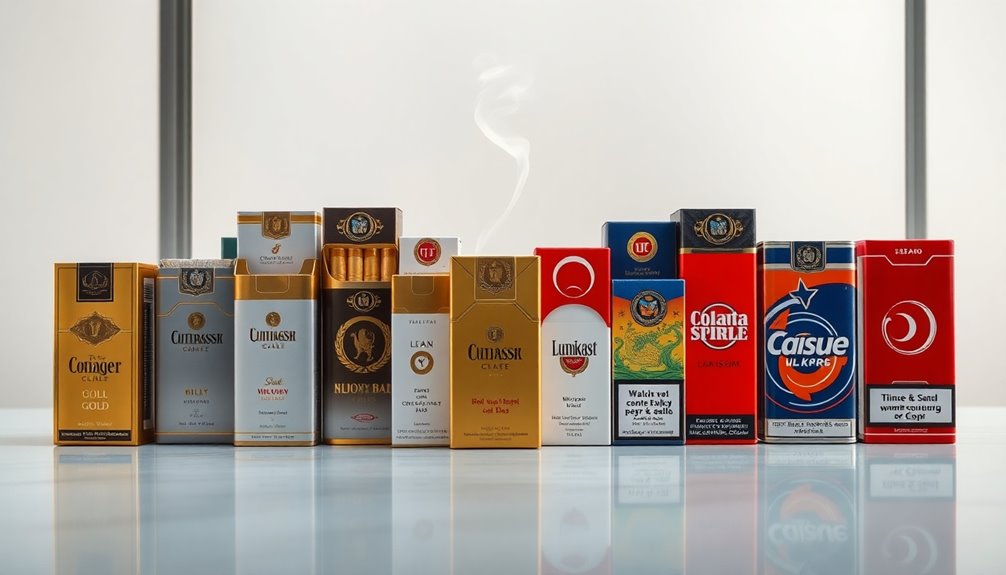
As regulations tighten and public health concerns grow, the future of cigarette brands is shifting towards innovation and adaptation.
You'll notice that tobacco companies are investing heavily in alternative products like heat-not-burn devices and e-cigarettes. These innovations aim to cater to smokers looking for safer options, responding to the increasing scrutiny from regulators such as the US Food and Drug Administration. With smoking prevalence declining, the focus on these alternatives is becoming increasingly crucial.
The rise of heat-not-burn products, like Philip Morris' iQOS, reflects a significant shift in consumer preferences, with sales expected to soar. Although traditional cigarettes still generate substantial revenue, the industry's landscape is changing rapidly.
You'll see a growing emphasis on biodegradable filters and sustainable production methods, aligning with environmental concerns.
Moreover, advertising and distribution strategies are evolving too. Convenience stores remain vital for tobacco sales, but companies are adapting their promotional tactics to meet the changing regulations and consumer demographics.
As you navigate the future of cigarette brands, keep an eye on how these companies balance compliance with innovation, and how government acceptance of new products will shape their success in a more health-conscious world.
Frequently Asked Questions
What Factors Influence Turkish Cigarette Pricing?
Turkish cigarette pricing is influenced by several factors.
You'll notice that taxation plays a significant role, with high excise taxes making cigarettes more expensive. Additionally, economic growth increases affordability, leading to greater demand.
Price sensitivity varies by income level; poorer households react more strongly to price hikes. Rising production costs and inflation also impact pricing.
Lastly, market dynamics, including the shift towards foreign brands, further shape the cigarette pricing landscape in Turkey.
Are There Any Unique Packaging Designs for Turkish Brands?
Yes, Turkish brands often feature unique packaging designs that stand out.
You'll notice vibrant colors and intricate graphics, reflecting themes of luxury and exoticism. Brands like Murad emphasize their heritage through detailed Orientalist artwork, which you might find appealing.
Packaging innovations, such as distinct shapes and hand-rolled designs, enhance their allure.
However, recent regulations may limit these creative elements, aiming to reduce the appeal of tobacco products, especially among younger consumers.
How Do Turkish Brands Compare to International Ones in Taste?
When you compare Turkish cigarette brands to international ones in taste, you'll notice distinct differences.
Turkish brands often deliver a rich, robust flavor that's deeply aromatic, appealing to local preferences. In contrast, international brands typically offer milder, lighter options, catering to a broader audience.
If you enjoy a unique taste experience, local brands might be your go-to. However, if you're after familiarity and consistency, international brands could suit you better.
What Are the Health Warnings on Turkish Cigarette Packs?
On Turkish cigarette packs, health warnings are prominent and cover at least 85% of the front and 100% of the back surfaces.
You'll see combined warnings that feature stark text in white on a black background, accompanied by vivid images and quitline info.
Each pack also displays a general warning on one side and an informational message on the other.
Misleading terms like "light" are banned, ensuring clarity in labeling.
Can I Find Turkish Cigarettes Outside of Turkey?
Yes, you can find Turkish cigarettes outside of Turkey.
Many international brands, like Camel, incorporate Turkish tobacco and are widely available across various countries.
While local Turkish brands may not have the same global reach, you'll often spot them in specialty shops or online retailers.
Keep in mind that availability might vary based on regional regulations and preferences, but the distinct flavor of Turkish tobacco keeps it in demand worldwide.
Conclusion
In conclusion, Turkey's cigarette market offers a fascinating mix of classic and contemporary brands. You've got notable local names alongside popular international ones, each catering to diverse preferences. As you explore your options, keep in mind the historical context and evolving regulations that shape the industry. Whether you're a long-time smoker or just curious, understanding these brands can enhance your experience. The future looks intriguing, so stay informed and make choices that suit your taste and lifestyle.
